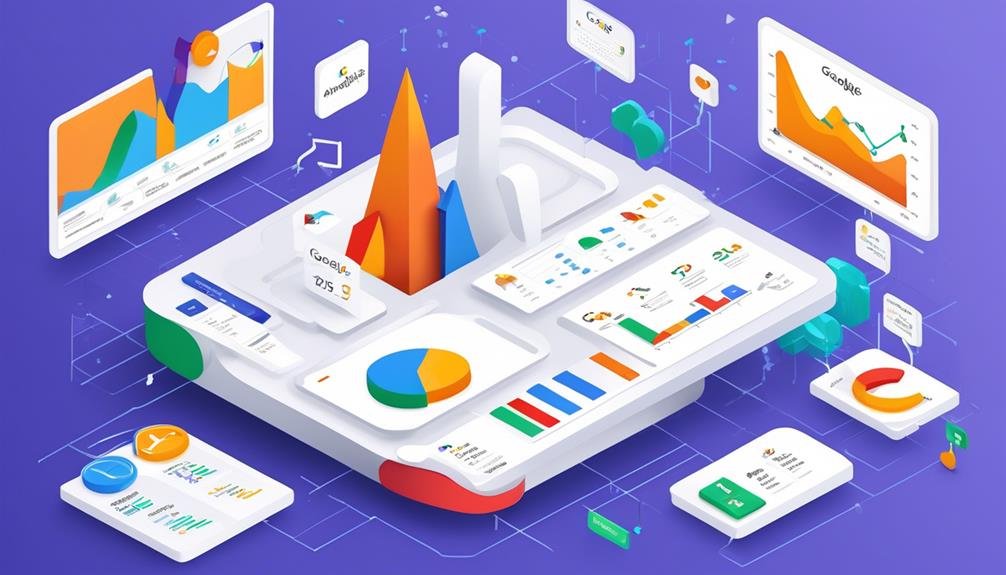So, you've got Google Analytics all set up for your website. You've heard it's a goldmine of data that can help you understand your visitors and improve your website's performance. But now you find yourself staring at the Google Analytics dashboard, wondering where to even begin.
Don't worry, analyzing visitor behavior may seem like a daunting task, but with a little guidance, you'll be able to uncover valuable insights that can drive your online success.
In this discussion, we'll explore the essential steps and features you need to know to make the most out of Google Analytics and gain a deeper understanding of your audience.
Get ready to unlock the secrets of visitor behavior and take your website to new heights.
Key Takeaways
- Setting up Google Analytics involves creating an account, obtaining a tracking code, placing the code on every page, and waiting for data collection to start.
- The Google Analytics dashboard has different sections for navigating, including Home, Real-Time, Audience, Acquisition, and Behavior, providing insights into key metrics and website activity.
- Key visitor metrics include sessions, pageviews, bounce rate, average session duration, and conversion rate, which help understand user engagement and website effectiveness.
- Analyzing user behavior can be done through audience reports, goal tracking, conversion analysis, and various analyses such as funnel visualization, behavior flow analysis, and landing page analysis.
Setting up Google Analytics
To get started with Google Analytics, you'll need to set it up on your website to track and analyze visitor behavior. Setting up Google Analytics is a straightforward process that can be done in a few simple steps.
First, you'll need to create a Google Analytics account by signing up on the Google Analytics website. Once you've created an account, you'll be given a unique tracking code that needs to be placed on every page of your website. This code allows Google Analytics to collect data on visitor behavior and track important metrics such as page views, bounce rate, and average session duration.
To insert the tracking code, you can either add it directly to the HTML code of your website or use a plugin or extension if you're using a content management system like WordPress.
Once the tracking code is in place, it may take a few hours for Google Analytics to start collecting data. You can then access your Google Analytics account to view reports and analyze visitor behavior.
The reports provide valuable insights into how visitors are finding and interacting with your website, allowing you to make data-driven decisions to improve user experience and achieve your website goals.
Navigating the Google Analytics Dashboard
The Google Analytics dashboard provides a comprehensive overview of your website's performance and visitor behavior, allowing you to easily analyze and interpret key metrics to inform your data-driven decision-making process.
When you log into Google Analytics, you'll be greeted with the dashboard, which is divided into different sections to help you navigate and access the information you need.
The left-hand sidebar contains various tabs that allow you to explore different aspects of your website's performance.
The Home tab provides an overview of your website's key metrics, such as the number of sessions, users, and page views.
The Real-Time tab shows you the current activity on your website, including the number of active users and the pages they're viewing in real-time.
The Audience tab provides insights into your website's visitors, such as their demographics, interests, and behavior.
The Acquisition tab focuses on how visitors are finding your website, whether through organic search, referrals, or social media.
The Behavior tab shows you how visitors are interacting with your website, including the most popular pages, the average time spent on each page, and the bounce rate.
Understanding Key Visitor Metrics


Understanding key visitor metrics is essential for gaining valuable insights into your website's performance and optimizing your digital strategy. By analyzing these metrics in Google Analytics, you can better understand who your visitors are, how they behave on your site, and what actions they take. This information can help you make data-driven decisions to improve user experience, increase conversions, and drive more traffic to your website.
To help you get started, here is a table outlining five key visitor metrics and their definitions:
| Metric | Definition |
|---|---|
| Sessions | The number of times users are actively engaged with your website, including both new and returning visitors. |
| Pageviews | The total number of pages viewed by visitors on your website. This metric includes multiple views of the same page by the same visitor. |
| Bounce Rate | The percentage of single-page sessions where visitors leave your website without interacting with any other page. A high bounce rate may indicate a lack of engagement or relevancy. |
| Average Session Duration | The average length of time visitors spend on your website during a session. This metric can help you understand how engaging your site is and identify areas for improvement. |
| Conversion Rate | The percentage of visitors who complete a desired action, such as making a purchase or filling out a form. This metric is crucial for measuring the success of your website in achieving its goals. |
Analyzing User Behavior Through Audience Reports
Gain valuable insights into user behavior on your website by analyzing audience reports in Google Analytics. These reports provide you with data-driven information about your website visitors, allowing you to understand how they interact with your site and make informed decisions to optimize their experience.
Here are two key ways you can analyze user behavior through audience reports:
- Demographics and Interests: Discover the demographics of your website visitors, such as their age, gender, and location. This information can help you tailor your content and marketing strategies to better resonate with your target audience. Additionally, gain insights into their interests and affinity categories to understand what topics or products they're interested in, allowing you to create targeted campaigns.
- Behavior and Engagement: Dive deeper into user behavior by analyzing metrics like session duration, pages per session, and bounce rate. These metrics provide valuable information on how engaged your audience is with your website. For example, a high bounce rate might indicate that visitors aren't finding what they're looking for, prompting you to optimize your content or navigation.
Utilizing Goal Tracking and Conversion Analysis


To further enhance your understanding of user behavior on your website, let's now explore the power of goal tracking and conversion analysis in Google Analytics. Goal tracking allows you to measure specific actions or behaviors that you want your website visitors to take, such as making a purchase, filling out a form, or subscribing to a newsletter. By setting up goals in Google Analytics, you can track the conversion rate and gain valuable insights into the effectiveness of your website in achieving its objectives.
Conversion analysis, on the other hand, helps you understand the journey that users take on your website before they convert. This analysis allows you to identify the touchpoints and interactions that lead to conversions, enabling you to optimize your website and marketing efforts accordingly.
To illustrate the power of goal tracking and conversion analysis, here is a table showcasing some key metrics and insights that can be derived from Google Analytics:
| Metric | Description |
|---|---|
| Conversion Rate | The percentage of website visitors who complete a desired goal |
| Top Conversion Paths | The different touchpoints that users go through before converting |
| Goal Value | The monetary value assigned to each goal completion |
| Funnel Visualization | A visual representation of the conversion funnel, showing drop-off points and areas for improvement |
Frequently Asked Questions
How Do I Integrate Google Analytics With My Website?
To integrate Google Analytics with your website, you need to add a tracking code snippet to your website's HTML. This code will collect data on visitor behavior, helping you analyze and understand how users interact with your site.
Can I Track Individual User Behavior in Google Analytics?
Yes, you can track individual user behavior in Google Analytics. By setting up User-ID tracking, you can analyze specific actions taken by each user, gaining valuable insights into their behavior and preferences.
Are There Any Limitations to the Data Collected by Google Analytics?
There are limitations to the data collected in Google Analytics. It can't track individual user behavior, only aggregate data. However, it still provides valuable insights into visitor behavior and helps optimize website performance.
Can I Export the Data From Google Analytics to Other Tools or Platforms?
Yes, you can export data from Google Analytics to other tools or platforms. This allows you to analyze visitor behavior in different ways and integrate it with other data sources for a more comprehensive understanding.
How Can I Track the Effectiveness of My Marketing Campaigns Using Google Analytics?
To track the effectiveness of your marketing campaigns in Google Analytics, you can use the Campaigns report. It provides insights on key metrics like clicks, conversions, and ROI, helping you make data-driven decisions for better campaign performance.
Conclusion
In conclusion, analyzing visitor behavior in Google Analytics is crucial for understanding how users interact with your website. By setting up Google Analytics, navigating the dashboard, and utilizing key visitor metrics, you can gain valuable insights into user behavior.
Audience reports provide further analysis of user demographics and interests, while goal tracking and conversion analysis help measure the success of your website's objectives.
By leveraging these tools, you can make data-driven decisions to optimize your website's performance and improve user experience.
